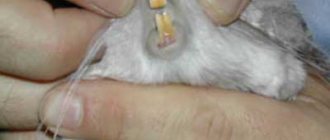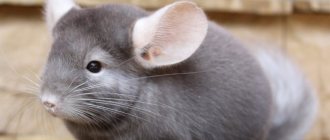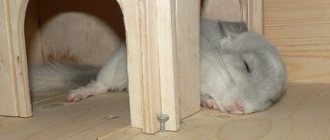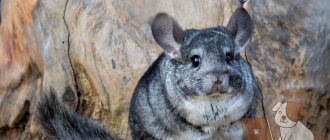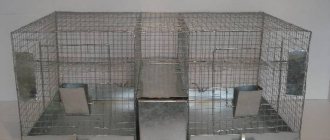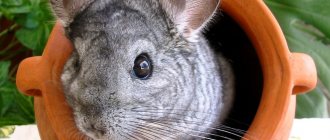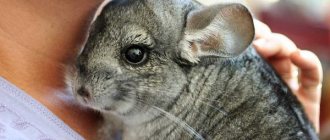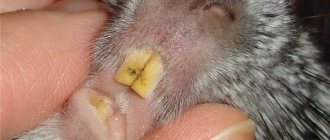How to determine the age of a chinchilla? Every person who wants to adopt such a pet faces this question.
There are several ways to determine the age of a chinchilla by external signs and weight, but in this way it is still impossible to determine the age accurately, however, there are clear differences between a young, adult and old individual.
If you want to get yourself this wonderful rodent, then, according to the recommendations of a specialist, you should do this when the puppy is about 3 months old. After all, such chinchillas eat food and are not attached to their mother, but are still small enough to get used to you as their owner.
The weight of a chinchilla baby at this age is approximately 350 grams, and the teeth of animals at such a young age are always white.
How many years do chinchillas live?
Chinchillas, unlike other rodents, live quite a long time. At home, a pet can live up to 20 years. But only with proper care. Chinchillas are very sensitive to any changes - temperature changes, moving, changing food. If you protect the fluffy from gross mistakes during maintenance, he will delight his owners for a long time.
In their natural habitat, chinchillas live much shorter lives - on average 8-10 years. Early mortality is associated with the presence of natural enemies in nature, poor nutrition in rocky areas, and lack of veterinary care in case of illness. Because of their valuable fur, chinchillas often become victims of poachers. Due to the decline in numbers in nature, these rodents were listed in the Red Book of the International Union for Conservation of Nature.
Among domestic chinchillas there are real long-livers. The oldest representative of this rodent species died at the age of 29.5 years. But this is only an officially recorded record. It is possible that chinchillas can live longer.
Let's create good conditions for the animal
The lifespan of a chinchilla at home depends on what to feed it and how to care for it. At home, the chinchilla is kept in a cage, and from time to time it is released so that it can run around the apartment.
Article on the topic: Is it worth getting a chinchilla: the pros and cons of a pet in an apartment
The chinchilla is a very active animal; if it is constantly kept only in a cage, its life expectancy will be significantly reduced. Chinchillas living in spacious cages and often walking in the wild look better, have a good appetite and good health, which means they are more likely to live up to 25 years or more.
A chinchilla's cage must be at least 60x60x60 cm, otherwise the animal will be constantly under stress and may get sick.
The cage should have the following equipment: a feeding trough, a drinking bowl, a house where you can hide and rest.
Drinker and feeder
The drinking bowl and feeder should be hinged so that the animal cannot turn them over and so that they do not take up precious space in the cage. Mineral and salt stones will be useful for the animal - it will be possible to grind teeth on them and receive additional minerals and vitamins. For hay, a special lattice is installed - a hay rack.
The floor of the cage is covered with sawdust or shavings, which are changed when dirty. To prevent the animal from getting bored, a running wheel with a diameter of 30 cm or more can be installed in the cage. It is advisable that it be made of wood.
The chinchilla is not washed in water, this causes its skin to deteriorate, but the animal willingly bathes in sand, so from time to time you need to put a container with sand in the cage for hygiene procedures.
Chinchillas will like special wooden toys - preferably made from birch. Coniferous wood cannot be used to make cages, toys, shelves and wheels for a chinchilla; it will chew them and be poisoned by the resin. You can also hang a hammock in the cage made of durable fabric that won’t be easy to chew through. All kinds of rings, hollows, ladders will help the chinchilla lead an active lifestyle and diversify its pastime.
Article on the topic: Is it worth getting a chinchilla: the pros and cons of a pet in an apartment
According to the observations of the owners of pet chinchillas, these animals are quite smart and observant, they can open the cage on their own if the constipation on it is weak and simple - you need to pay special attention to this point when choosing a cage.
The normal temperature for chinchillas will be +20-22 degrees, so the cage should not be placed near a radiator, heaters or in places exposed to direct sunlight. The place should be cool, but without drafts or dampness. You should not place the cage near electrical wires; the chinchilla should not be able to reach them.
Development by months
It is possible to determine the age of a chinchilla depending on its body parameters only when the animal reaches one year of age. From this period, the maturation of fluffies is considered completely complete. To make it easier to determine the age of young animals, you can use the following table:
| Age in months | Height in centimeters | Weight in grams | ||
| Males | Females | Males | Females | |
| 0 | 3-5 | 3-5 | 30-70 | 30-70 |
| 1 | 9-10 | 10-12 | 85-135 | 95-145 |
| 2 | 12-15 | 15-16 | 200-250 | 250-300 |
| 3 | 15-17 | 17-18 | 230-300 | 280-330 |
| 4 | 17-18 | 19-22 | 335-380 | 350-400 |
| 5 | 18-19 | 23-24 | 375-440 | 450-500 |
| 6 | 19-20 | 25-26 | 415-470 | 475-550 |
| 7 | 20-21 | 26-27 | 430-490 | 450-580 |
| 8 | 21-22 | 27-28 | 440-500 | 460-600 |
| 9 | 23-24 | 29-30 | 460-520 | 580-630 |
| 10 | 24-25 | 31-32 | 500-550 | 600-680 |
| 11 | 25-26 | 33-34 | 530-600 | 650-720 |
| 12 | 26-27 | 35-36 | 590-650 | 700-800 |
It is worth noting that the data presented in the table are averages. Since the size of chinchillas can vary significantly depending on housing conditions, feeding and health status. For example, chinchillas raised in nature will be 10-15% smaller than fluffies raised at home.
Natural enemies
In their natural habitat, rodents become food for foxes, snakes, and large birds of prey. Protection from enemies is the camouflage coloring of the fur, good reaction and coordination, and speed of movement. Hiding from persecution, chinchillas hide in crevices and voids. The structural features of the skeleton enable the animal to penetrate narrow openings and crevices. Another unique feature of the chinchilla is that it can literally shoot out tufts of fur, discarding it in the place where the predator has grabbed hold.
A LION
How to distinguish young from old
Even if it is not possible to accurately determine the age of a chinchilla, you can at least roughly determine whether it is a young fluffy or an adult. The following signs are usually used as clues:
- Condition of teeth . The lighter they are, the younger the animal. Like all rodents, chinchilla babies are born with white teeth. In breastfed babies, their color does not change. With the introduction of plant foods into the diet, the teeth gradually turn yellow. With age, their color becomes more saturated, even turning orange in old age. This effect is explained by the constant thickening of tooth enamel, which has a yellow color. After all, adult chinchillas often have to deal with rough food, for example, nut shells or tree bark, so their teeth must be strong.
- Head and neck shape . Baby chinchillas are born with a round face and the same round ears, which makes them very cute. With age, the structure of the skull of these rodents changes slightly - the parietal bones of the skull become elongated. This leads to the fact that the animals' faces look more pointed. Also, young chinchillas have a stronger, short neck, which becomes more elongated with age.
- Dark spots . Similar to hyperpigmentation in older people, melanin synthesis also increases with age in chinchillas. Therefore, chinchillas older than 4-5 years old gradually develop pigment spots, the size and number of which only increase over time. The spots are localized mainly on the sensitive skin of the ears and on the pads of the paws.
- Tail . A beautiful fluffy tail indicates that the chinchilla is young and in the prime of life. The tail of young animals is somewhat more modest, since it has not yet developed long, shiny fur. And old chinchillas have a fluffy tail, but the fur on it is no longer so hard - soft and dull.
- Skin condition . The younger the chinchilla, the softer the skin on its heels. Babies' heels are completely silky to the touch and have a soft pink color. By about 5 years of age, the skin on the pads of the paws darkens, and the first calluses appear on the heels. By the age of 7-8 years, rough calluses appear on the paws. The roughening of the skin on the feet of chinchillas is explained by constant climbing on shelves and other vertical surfaces.
- Expressiveness of secondary sexual characteristics . The younger the chinchilla, the more difficult it is to distinguish a boy from a girl directly by the genitals. If the sex of the animal is clearly visible, the chinchilla has already crossed the age threshold of 7-8 months. It is by this period of life that the formation of the organs of the reproductive system in rodents is completely completed.
- Voice . Young chinchillas are more sociable - they often express their emotions (both positive and negative) by squeaking, screaming, and snorting. While older individuals prefer to “be silent”, even when they experience discomfort.
The habits and character of the animal can also tell about the age of a chinchilla. Young pets are more active and inquisitive - they constantly explore the world around them, sniffing everything and testing their teeth. While in a cage, the young animals spend most of their free time playing and exercising on apparatus. At the same time, adult individuals prefer to while away their time alone, sleep a lot or just sit in their house. Also, young chinchillas are more willing to make contact with humans.
Animal character
According to reviews of chinchilla owners, the character of these animals can be different - kind and calm, or vice versa - aggressive and quarrelsome. Often these qualities are developed in chinchillas under the influence of educational techniques and attitudes on the part of the owners.
At the same time, all chinchillas also have common character traits - intelligence, cunning, timidity, a desire to defend their territory and adaptation to a permanent place of residence.
In a new place, the chinchilla will experience stress at first, but will gradually begin to get used to it and will soon become completely accustomed to its new environment. At this time, it is important to treat the animal with affection and care so that the adaptation period passes quickly and without complications.
The animal is gradually accustomed to handling hands by giving food from the palms - this can be dried fruits or dried rose hips. Gradually, the chinchilla will get used to the hands and will run to them for a treat, but under no circumstances should you catch it in the cage - this will make it even more frightened.
Tamed chinchilla
A tamed chinchilla no longer hides from its owners, but happily sits in their arms, plays and happily welcomes them home from work.
Article on the topic: Do guinea pigs stink or not, the reasons for the smell from a rodent
Those who have decided to keep a chinchilla at home should know that this is a nocturnal animal - it becomes most active at night, sleeping during the day. Knocks, sounds and noises at night from the animal will be a common occurrence, and it will be difficult to sleep in such conditions.
Chinchillas express all their emotions with certain sounds. They usually “talk” with a kind of cooing or hooting, which can be used to determine their mood.
If a chinchilla makes sounds reminiscent of grasshoppers, it means that it is scared and is going to defend itself. Most often, these sounds are heard when someone wants to pick up a chinchilla against its will.
An alarming state is indicated by sounds similar to a dog barking and a loud cry. In nature, chinchillas bark as a sign when they see something unusual that is fraught with danger. A chinchilla produces a piercing cry when she is hurt, as well as when she is very frightened. If your chinchilla makes sounds of anxiety and pain too often, you should take him to the vet.
Although these animals make a lot of noise, they do not like extraneous and loud sounds - so there is no need to place the chinchilla’s cage near the TV or other constantly running household appliances.
How to tell if a chinchilla is elderly
In addition to the listed signs by which you can distinguish a young chinchilla from an adult, there are several more distinctive features that indicate that the animal is not just old, but very old:
- the pet’s movements are inhibited - it moves slowly and measuredly from one place to another, and coordination disorders may be observed;
- lack of a natural reaction to current events - the pet does not pay attention to loud sounds, bright lights, strangers;
- the teeth are crumbled or severely worn out - the enamel of an old animal becomes very fragile and becomes stained even when eating medium-hard food;
- poor condition of the coat - dullness and severe hair loss, sometimes even bald patches may appear;
- clouding of the eyes - a young chinchilla’s eyes sparkle playfully in the light, while an old chinchilla’s eyeballs are covered with a veil;
- the animal has lost the ability to navigate with the help of smell - if a young pet accurately finds a hidden treat, then an elderly chinchilla will not be able to do this.
If a chinchilla has at least one of the listed signs, most likely it is at least 14 years old. It is better to refuse to buy such an old animal. After all, the pet will have problems not only with health, but also with getting used to the new owner.
Also, after 12 years, the reproductive function of chinchillas gradually fades away. This age is similar to the human menopause. However, unfortunately, when purchasing an animal, its ability to reproduce cannot be checked.
Reproduction
Chinchillas reach sexual maturity at the age of 6-9 months, with females maturing earlier than males. Despite the fact that rodents live in colonies, mating occurs with one permanent partner.
The first rut begins in the spring. The gestation period lasts a little more than 3 months. During this time, the female noticeably gains weight, and just before giving birth, she practically stops moving. 2-3 cubs are born in one litter. The animals are born sighted, they have teeth and are covered with fur. The female feeds the babies with milk for up to two months, but already on the 2-3rd day they begin to try plant foods.
Females give birth 2-3 times a year. Re-coating by the male occurs almost immediately after birth. Despite the ability of chinchillas to produce offspring several times per season, reproduction of the species does not occur as intensively as in other rodents due to the small number of litters.
Watch this video on YouTube
Chinchilla to human age ratio
It is not surprising that after purchasing a chinchilla, new owners are interested in how the pet’s age compares with that of a human. Scientists have not yet derived the exact formula. However, an indicative table of the relationship between the ages of chinchillas and humans still exists:
| Chinchilla age (years) | Person's age (years) |
| 0,5 | 16-17 |
| 1-2 | 20-25 |
| 3-4 | 26-32 |
| 5-6 | 33-38 |
| 7-8 | 39-44 |
| 9-10 | 45-49 |
| 11-12 | 50-56 |
| 13-14 | 57-63 |
| 15-16 | 64-70 |
| 17-18 | 70-75 |
| 19-20 | 76-82 |
As can be seen from the table, by the age of 14-15 years a chinchilla can definitely be called elderly. Usually, upon reaching this age, furry cats, like people, begin to develop numerous diseases. These can be benign and malignant tumors, atherosclerosis, heart attacks and strokes, slow metabolism. However, if you consult a veterinarian in a timely manner, most diseases can be successfully corrected and the life of your pet can be extended to 20-25 years.
In fact, finding out the age of a chinchilla and distinguishing a young animal from an older one is not so difficult. The main thing is to remember the main distinctive features and try to apply them in practice. But even if you make a mistake and buy an older chinchilla, you shouldn’t be upset; an elderly pet is also capable of giving all family members a lot of love and other positive emotions.
Productivity
Initially, the breed was conceived as a skin breed, and meat characteristics came as an additional bonus. However, in practice, breeding chinchilla rabbits pursues both goals - obtaining both meat and skins.
The quality of the fur of the Soviet chinchilla is on average one and a half to two times better than that of ordinary rabbits. For this reason, chinchilla skins are readily purchased by enterprises specializing in the production of fur products.
Moreover, often the fur does not even have to be tinted, as is the case with the fur of other breeds of rabbits. The natural color looks solid enough to be used in its original form.
As for meat indicators, the slaughter yield at 120 days of age in rabbits of this breed averages 56-58%.
This is noticeably lower than that of ordinary rabbits (60-62%), but do not forget that meat in this case is not the main product. However, some individuals provide even 63%.
Soviet chinchillas show fairly rapid growth rates in the first two months of life, but then slow down significantly.
Having a birth weight of about 75 grams, on the 60th day they reach an average of 1.8 kg, after another month - 2.5-2.8 kg, on the 120th day - 3.5-3.7 kg. Fully mature rabbits weigh on average about 5 kg. Feed conversion per 1 kg of live weight gain in young animals is 3-4 kg.
The fertility of females is not very high: on average there are about 7-8 rabbits in one litter. Thanks to this moderate indicator, female rabbits can easily feed their offspring.
